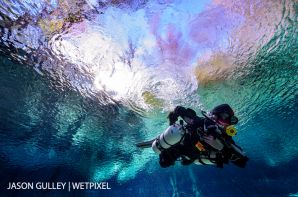Read MoreContinue Reading
The US state of Florida boasts more than 1,000 springs. Most of these springs discharge crystal clear groundwater from the porous limestone bedrock that makes up the Floridan aquifer – one of the most productive and spring-dense aquifers globally. These springs’ future is threatened by increasing groundwater consumption needed to slake the thirst of a growing population and expand agricultural industry and pollution from septic tanks, farm animal waste, and fertilizer. Over the last several decades, water flow from some springs has slowed to a trickle, and thick blankets of hairy algae have smothered the native vegetation in most springs.
I’ve witnessed the slow death of Florida’s springs over more than two decades of cave diving and spent the last 10 years studying Florida’s springs as a geology professor. While my research has improved my academic understanding of springs, I’ve gradually realized that writing another research paper doesn’t help the public understand Florida’s springs or inspire them to care about the slow-moving environmental catastrophe they’re facing. Regular people don’t read or understand academic papers. The average citizen doesn’t have an emotional reaction to a graph. But most people, scientists included, are captivated by engaging pictures. In 2019, I decided to combine my passions for environmental research and photography to take pictures and write captions that help people learn about Florida’s springs and the creatures that depend on them.
I shoot underwater with a Nikon Z6 in a Nauticam housing with a 230 mm glass dome. I use Nauticam’s 45-degree viewfinder to make it much easier to view the EVF while maintaining horizontal trim, which is essential for cave work. I have a strong preference for rectilinear lenses, and the Nikon Z 14-30mm f/4 has been my go-to choice underwater. I’ll break out my Nikon Z 24-70 f/4 or my Sigma 15mm f/2.8 fisheye lens on rare occasions. I’m not a big fan of fisheye distortion, and I have to focus this lens manually on the Z6, so I typically only use the Sigma if there is a chance that I’ll be shooting over-under shots on the surface. I experiment quite a lot with longer shutter speeds (up to several seconds) to create motion blur, both inside caves and on the surface. Sometimes I’ll combine the longer shutter speeds with rear curtain flash to freeze motion in part of the frame. On the surface, I rely on ambient light and small apertures for motion blur. I combine background light provided by up to 4 Big Blue 33k lumen video lights with 1 or 2 on-camera Inon Z330 strobes and diffusers in caves. Lastly, I’ve been using rebreathers for almost 20 years for technical dives, and they have provided me with tremendous flexibility for shooting underwater. Nearly all of my dives are limited by camera battery capacity, and I eagerly await the ability to get bigger battery packs inside my housing.
You can keep up with my latest photo projects by following me on Instagram – @jason_gulley_science.
Continue Reading![]()

